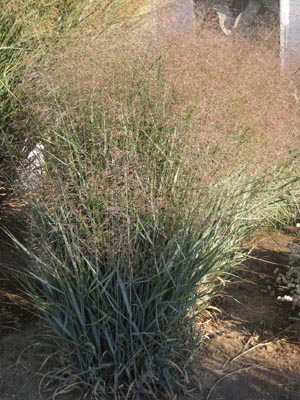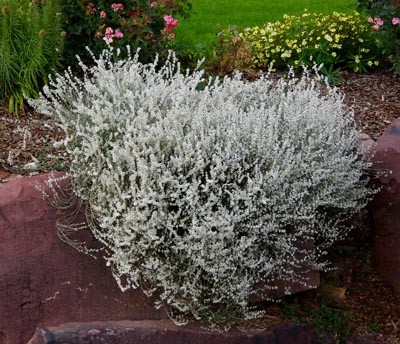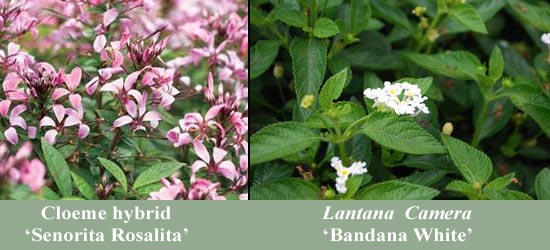Featured Annuals
By Robin Boutilier
Good Earth Garden Center
Lantana camara ‘Bandana White’ and Cleome hybrid ‘Señorita Rosalita’
Cleome hybrid ‘Señorita Rosalita’ is a welcome new addition to my garden. In the past I had appreciated the height that cleome would lend to my borders, but found them difficult to work around. The sticky leaves, thorny stems, and the rather skunky scent of the old cleome varieties were reason enough for me to banish them from the garden. Enter ‘Señorita Rosalita’! The first thing I noticed about this plant was the beautiful dark, green foliage, noticeably more substantial than the cleome of bygone days, and no thorns, no scent. As the season progressed, I was thrilled to see large heads of clear, pink blooms, no dead-heading required. The spidery flowers are attractive to both butterflies and birds. Since Cleome ‘Señorita Rosalita’ is also drought tolerant, it provided stellar companions to Salvia ‘Carradona’, and Lychnis ‘Gardener’s World’. A large container would be required to accommodate ‘Señorita Rosalita’ and a few companions, but the combination of stately, pink cleome, hot pink geraniums, and royal purple calibrachoa to trail down the sides is a winner.
Lantana camara ‘Bandanda White’ is the star of my patio containers. At night the abundant white flowers are visible as dusk settles, and the last of the dinner dishes are cleared. During the day, the noticeably larger flowers glisten above crisp, green foliage with a casual elegance. Paired with lotus vine, or dichondra, as a trailer, it may be all you need for a medium-sized container. Though the flowers aren’t scented, the foliage emits an evocative grapefruit scent when brushed. The ‘Bandana’ series of lantana is known for its upright, mounding habit, prolific branching, and earlier flowering than other varieties of lantana. Lantana’s, in general, are heat and drought tolerant and low maintenance. In the xeric garden, ‘Bandana White’ would be absolutely stunning when paired with any of the ‘Profusion’ series of zinnia, or the vibrant blue of Salvia patens ‘Blue Angel’. Since the color white plays so well with others, it makes Lantana ‘Bandana White’ an especially versatile addition to your garden. Go to www.gardencentersofcolorado.org for more info.
Cleome ‘Señorita Rosalita’
Height: 24 to 36 inches
Width: 20 inches
Full Sun, heat tolerant, somewhat drought tolerant
Vertical habit
For use as a vertical component in large containers, or for height in landscape beds
Lantana ‘Bandana White’
Height: 20 inches
Width: 24 inches plus
Full Sun, heat and drought tolerant
Mounding habit
For use in containers or landscape
Featured Perennials – Pennywise Perennials
By Betsy Kelson, CCNP
Jared’s Nursery & Garden Center
Soothing Panicums

Switch grass (Panicum virgatum) has found a home in many gardens in spite of its humble beginnings as a dominant plant species of the tall grass prairie. Imagine a clumping warm season grass reaching 4 to 7 feet tall. Imagine a light breeze making the grass sway and rustle gently in its caress. Then, imagine the late afternoon or early morning sun shining through the silver highlights of the seed heads. Run and get the camera. And as if that was not enough, in the winter, the light snows and frosts are caught like powdered sugar on the seed panicles and leaves. Or bring it inside as filler for fresh or dried arrangements.
Depending on the variety, switch grass can reach a height of 3 to 7 feet leaving it available as a background plant or as an accent in the middle of a border. Adding to its appeal, switch grass will produce beautiful seed panicles beginning in July, shooting 12 to 24 inches above the foliage. To finish off the season, the interesting blue to grey green foliage turns to shades of yellow, orange, or red.
To make more of your favorite switch grass, get the shovels and garden forks out in the spring. Like many garden perennials, the switch grass clump can be dug up, and cut or literally ripped apart into smaller pieces. This method ensures an exact copy of the parent plant. Many of the named cultivars of switch grass like ‘Heavy Metal’ will not produce seed that grows into the original plant. Plant the pieces into fertile well-drained soil in full sun. However, most switch grasses can tolerate light shade as well as sandy or heavy clay soils if watering is carefully monitored.
Another method is to plant seed. As mentioned above, the seed from named varieties may not look exactly like the parent plant or may not germinate at all due to sterility. But if you want to give it a go, collect the seed in the fall and plant into the garden in the fall or spring. OR if more control is needed, plant in pots outside for the winter.
Visit www.coloradonga.org home gardeners for gardening information and to find a local independent retail location
Plant Select® Promotional Article
By Mike Bone
Denver Botanic Gardens
Snow Mesa Buckwheat (Eriogonum wrightii var. wrightii)
Perennial
Height: 18 to 20 inches
Width: 18 to 24 inches
Blooms: August to November
Sun: Full sun
Soil Moisture: Dry conditions best; xeric. (Little to no irrigation needed once established.)
Hardiness: USDA zones 4 to 9 (up to 8000 feet)
Culture: Can be floppy in too rich of soil or with excessive watering. Grow lean and dry for best results.
The Wright Buckwheat for your Xeriscape

Year round interest, amazing seasonal transformations, color changing flowers, and the ability to withstand blazing heat and the driest conditions. Is this the tagline for the next superhero movie??? NO, it’s the tagline for one of the most fascinating western native plants about to become the star of your garden. Eriogonums are widespread in the western landscape and can be found in almost any vignette. Snow Mesa Buckwheat (Eriogonum wrightii) starts the season off as a soft textured ever-silver mat that creeps along pathways and hugs close to rocks or containers. In late July, the low tight mat grows long tortuous stems akin to the Mormon teas with which it is often found growing. You look and wonder what could possibly happen next, can this plant get any stranger? Then it explodes with a frothy exuberance that changes the nature of the plant into a dancing cascading masterpiece of clean white. Not yet out done, the floral display transforms in fall to rust colors welcoming the changing season, softening your border and making a full turn for the year.
This indigenous plant has an incredible distribution throughout the Colorado Plateau with great variability in form and variety. From miniature mats only a couple of inches around that grow to the edge of tree line, to the stately form that Plant Select® is proud to bring you that is found jutting out of the blackened earth in the alien rockscape of the El Malpais in New Mexico. They are easy to grow and thrive in challenging areas of the garden. Plants at Denver Botanic Gardens have been a staple of our Watersmart garden as well as the Rock Alpine garden and the Conifer berm. When they are blooming they take center stage and command visitors’ attention. This is one of the best plants for your xeric garden and dry sections of the perennial border. Don’t wait for the sequel – this one tops the charts now.
Articles and photos courtesy of the Colorado Nursery & Greenhouse Association
Visit www.coloradonga.org home gardeners for gardening information and to find a local independent retail location.
Go to www.gardencentersofcolorado.org where you can find out more about the many wonderful plants that are perfect for Colorado gardens and the garden centers that provide them.
